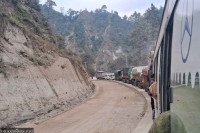Editorial
Break the fall
The continued slowdown of the economy hints at much tougher fiscal days ahead.
If our economic situation was not already dire, the World Bank Nepal Development Update has come up with more bad news, with a fresh situation report that shows Nepal is headed for more slow down amid rising domestic and external challenges. Import restrictions, monetary policy tightening, higher inflation and shrinking government expenditure, the World Bank has said, are some reasons for the slowdown. The latest projection, released on Tuesday, said Nepal’s economy would grow by 4.1 percent in the fiscal year 2022-23, ending mid-July, a downward revision from the October 2022 forecast.
The update has said wide-ranging import restrictions negatively impacted growth as fiscal revenues saw a steep fall, leading to temporary and permanent dislocations. For a country heavily reliant on taxation, the government’s import restrictions led to an even slower growth and a loss of revenues in the first half of the fiscal year 2022-23. Consumer prices rose the most since fiscal year 2016-17, with a 7.5 percent increase in food prices and an 8.7 percent hike in non-food items.
The update has further flagged a decline in construction that has in turn contributed to a slow economic growth in the current fiscal year. It has also speculated higher-than-expected inflation to reduce household purchasing power. The Covid-19 pandemic had been on a lull for almost a year, and yet we failed to hit the road to recovery. Now that Covid-19 cases are rising again, there are many other potential obstructions on the road ahead.
The government has failed to curb inflation internally even as the country faces the ripple effect of a global inflation which, thankfully, is expected to fall to 6.6 percent in 2023 compared to 8.8 percent in 2022, as per a forecast from the International Monetary Fund. But we also have our own idiosyncratic problems: For months last year, the then minister Janardan Sharma and the Nepal Rastra Bank Governor Maha Prasad Adhikari tussled, precluding any chances of working in symmetry to gin up the economy. And after months of political transition, from the elections to the making and unmaking of governments in two months, there has hardly been any focus on economic recovery.
There are, however, some positive signs: A comparatively better foreign exchange reserve, a sustainable growth in credit, a higher influx of tourists, and a growth in remittance. To sustain these, though, there is a need for political stability. Now that the Cabinet is on its way to taking full shape, the government should work swiftly to curb inflation and create an environment for more growth, including a sustained effort on job-creation.
The failure to stabilise politics has long been reflected in the economic downturn that Nepal faces today. Politicians only seem interested in shaping a government of their interest, irrespective of the overall health of the economy and wellbeing of its people. In this scenario, the World Bank has also highlighted how political instability in Nepal has led to the economic downturn of the country. The bank has recommended that the country follow the government's “Green, Resilient and Inclusive Development” more rigorously to salvage itself from the ongoing crisis. Again, easier said. But if not, what then is the alternative?




 5.14°C Kathmandu
5.14°C Kathmandu














